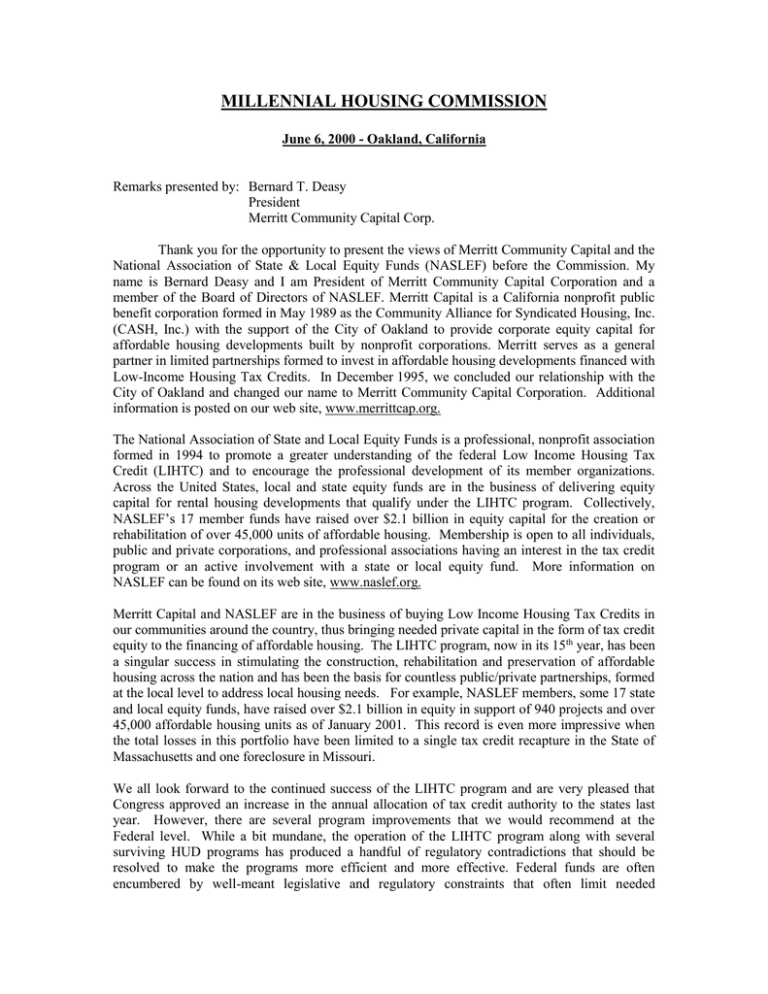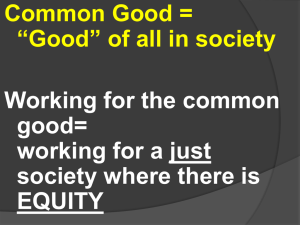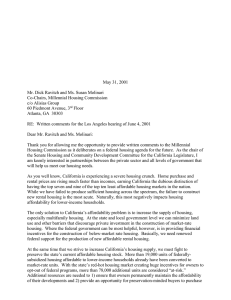MILLENNIAL HOUSING COMMISSION
advertisement

MILLENNIAL HOUSING COMMISSION June 6, 2000 - Oakland, California Remarks presented by: Bernard T. Deasy President Merritt Community Capital Corp. Thank you for the opportunity to present the views of Merritt Community Capital and the National Association of State & Local Equity Funds (NASLEF) before the Commission. My name is Bernard Deasy and I am President of Merritt Community Capital Corporation and a member of the Board of Directors of NASLEF. Merritt Capital is a California nonprofit public benefit corporation formed in May 1989 as the Community Alliance for Syndicated Housing, Inc. (CASH, Inc.) with the support of the City of Oakland to provide corporate equity capital for affordable housing developments built by nonprofit corporations. Merritt serves as a general partner in limited partnerships formed to invest in affordable housing developments financed with Low-Income Housing Tax Credits. In December 1995, we concluded our relationship with the City of Oakland and changed our name to Merritt Community Capital Corporation. Additional information is posted on our web site, www.merrittcap.org. The National Association of State and Local Equity Funds is a professional, nonprofit association formed in 1994 to promote a greater understanding of the federal Low Income Housing Tax Credit (LIHTC) and to encourage the professional development of its member organizations. Across the United States, local and state equity funds are in the business of delivering equity capital for rental housing developments that qualify under the LIHTC program. Collectively, NASLEF’s 17 member funds have raised over $2.1 billion in equity capital for the creation or rehabilitation of over 45,000 units of affordable housing. Membership is open to all individuals, public and private corporations, and professional associations having an interest in the tax credit program or an active involvement with a state or local equity fund. More information on NASLEF can be found on its web site, www.naslef.org. Merritt Capital and NASLEF are in the business of buying Low Income Housing Tax Credits in our communities around the country, thus bringing needed private capital in the form of tax credit equity to the financing of affordable housing. The LIHTC program, now in its 15th year, has been a singular success in stimulating the construction, rehabilitation and preservation of affordable housing across the nation and has been the basis for countless public/private partnerships, formed at the local level to address local housing needs. For example, NASLEF members, some 17 state and local equity funds, have raised over $2.1 billion in equity in support of 940 projects and over 45,000 affordable housing units as of January 2001. This record is even more impressive when the total losses in this portfolio have been limited to a single tax credit recapture in the State of Massachusetts and one foreclosure in Missouri. We all look forward to the continued success of the LIHTC program and are very pleased that Congress approved an increase in the annual allocation of tax credit authority to the states last year. However, there are several program improvements that we would recommend at the Federal level. While a bit mundane, the operation of the LIHTC program along with several surviving HUD programs has produced a handful of regulatory contradictions that should be resolved to make the programs more efficient and more effective. Federal funds are often encumbered by well-meant legislative and regulatory constraints that often limit needed flexibility to meet community needs. Thee are fundamental and logical reasons to conform common definitions and requirements among affordable housing programs, especially in the areas of tenant eligibility, income certification procedures and rent limits. The more we can simplify existing regulations, processes, and paperwork, the more we can increase the efficiency of the public programs and leverage private sector participation. The examples include: 1. The use of a “building” (IRS) vs. a “project” (HUD) as the basic unit of a tax credit investment. This causes great confusion in determining the eligible basis for an investment as well as significant on going management problems in the allocation of affordable units to qualified applicants, such as the application of the next available unit rule and other occupancy standards included in the LIHTC regulations – Section 42 of the IRS Code. We urge the elimination of the “building” designation and the use of “project” as the basis unit to describe a LIHTC investment. After all, we invest in projects, not individual buildings. 2. Several programs, including HUD Section 8, Low Rent Public Housing, HUD Section 236 and 221(d)4 as well as the Tax Credit program contain conflicting occupancy regulations and practices. For example, the tax credit program has stringent limits on the eligibility of students while other programs have no such requirements; income limits and the determination of qualified income varies among the programs; the timing of tenant income certification and rectification is inconsistent among the programs. 3. The use of tax credits to finance the recapitalization of at risk HUD insured projects has only served to underscore the need for regulatory measures that ensure long term affordability. HUD programs created thousands of units of affordable housing in the past decades, but with 20-year regulatory agreements that are now burning off and many of those units are at risk of being lost as affordable housing resources. While many states have extended the affordability period under the Low Income Housing Tax Credit Program, the expiring Federal programs will continue to drain resources needed to create additional affordable units for the foreseeable future. It has been argued that the shorter affordability terms were needed to entice private investment in these programs. Nothing could be further form reality. Private developers are obsessed with the short term. Back end capital gains are not part of the equation and often only cause tax problems. The typical private developer is involved in affordable housing for the immediate fee income and not much else. Should there be a back end capital gain, then that’s great, but not necessary to ensure their participation in the development of affordable housing. The strongest, long term aspect of the Low Income Housing Tax Credit Program are the provisions for the transfer of the project to a non profit sponsor at the conclusion of the Tax Credit compliance period, thus ensuring true long term affordability. 4. Long term Federal commitment to an affordable housing finance scheme is lacking, even in the case of the recapitalization of an existing HUD at risk property. For example, lenders are reluctant to underwrite Section 8 rental income because the Feds limit the Section 8 Contract to an annual renewal. Many more projects would achieve financial feasibility if the full amount of the Section 8 revenues could be recognized in the underwriting process. In fact, the inability to include Section 8 rental revenue in the underwriting process actually provides more cash flow to the developer. The revenue is there as long as the Section 8 subsidy remains, but it is not counted in the projected cash flow. Also, if the Section 8 revenue is recognized, less Tax Credit equity would be needed and that equity could be used to support a higher number of units. The project must be feasible without the Section 8 revenues. However, if the Section 8 rental income is included in the underwriting, then other financial resources such as the LIHTC would be available to support a greater number of units. All of the other parties to the transaction are making long term commitments – all but Uncle Sam. The Tax Credit investor is in for a minimum of 15 years and the lenders have even longer commitment periods. The proposed resolution is to provide for longer Section 8 contract periods, especially in the cases of an existing HUD at risk project. In addition to the above specific program issues, the long-term success of the LIHTC program will depend in large measure on maintaining the low income housing tax credit as a desirable investment. Currently, banks and GSEs make up the major body of continuing investors, largely due to CRA requirements and the HUD housing goals assigned to Fannie Mae and Freddie Mac. While these investors have been the core investors in the program to date, Congress should explore ways to expand the investor base of the program. Without limiting the 15-year compliance period or the longer terms of affordability adopted by many states, the investor base could be greatly expanded by enhancing the liquidity of the tax credit investment. Fannie Mae and Freddie Mac are the financial powerhouses they are today because the mortgage market needed liquidity and a strong, efficient secondary market for single family mortgages. One could argue that the LIHTC markets needs the same consideration. Many successful corporations look at a tax credit investment and must make the determination that they will have on ongoing need for tax credits over a 10 to 15 year span. While many hope they will be that consistently profitable of the long term, they don’t believe it to the extent necessary to make a significant investment in affordable housing tax credits. However, if there was an active, functioning and accessible secondary market for the tax credit, many more firms would be willing to make the initial investment, secure in the knowledge that they could get out of the investment in the later years, should their appetite of tax credit diminish. One of our major investors, PG&E, has been facing this question and we have been concerned with the limited market, the need to bond or insure the transaction and the high cost of a secondary market sale. Liquidity is the key to a successful investment vehicle, and the LIHTC must move to develop and maintain a strong secondary market if it is to retain its place as the single most important source of equity for affordable housing developments.




